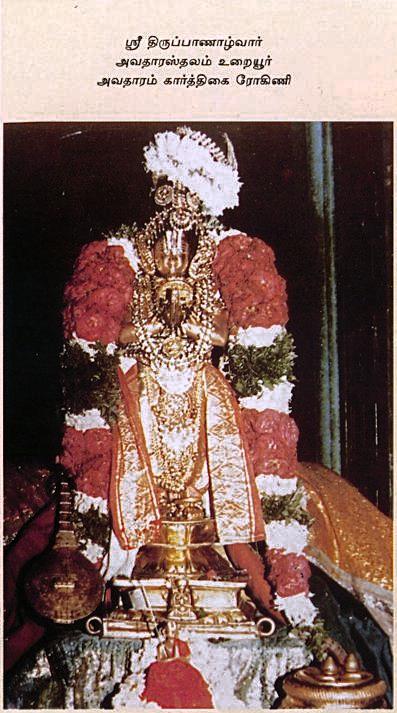Tirupp─Ђр╣Є Alvar
(redirected from Web.TiruppanAlvar)
• November 13, 1994
Tiruppaan Alvar's thirunakshatram falls on r┼Їhiр╣Єi in the month of K─Ђrttikai.

Tiruppaan Alvar's life is illustrative of what Sri Vaishnavas have always considered important, i.e., being a servant of Lord's servants. Nammalvar expresses this concept very forcefully in Tiruvaymoli 3.7.9:
Я«ЋЯ»ЂЯ«▓Я«еЯ»ЇЯ«цЯ«ЙЯ«ЎЯ»ЇЯ«ЋЯ»Ђ Я«џЯ«ЙЯ«цЯ«┐Я«ЋЯ«│Я»Ї Я«еЯ«ЙЯ«▓Я«┐Я«▓Я»ЂЯ««Я»Ї
Я«ЋЯ»ђЯ«┤Я«┐Я«┤Я«┐Я«еЯ»ЇЯ«цЯ»Ђ, Я«јЯ«цЯ»ЇЯ«цЯ«ЕЯ»ѕ
Я«еЯ«▓Я«еЯ»ЇЯ«цЯ«ЙЯ«ЕЯ«┐Я«▓Я«ЙЯ«ц Я«џЯ«БЯ»ЇЯ«ЪЯ«ЙЯ«│ Я«џЯ«БЯ»Ї-
Я«ЪЯ«ЙЯ«│Я«░Я»ЇЯ«ЋЯ«│Я»Ї Я«єЯ«ЋЯ«┐Я«▓Я»ЂЯ««Я»Ї,
Я«хЯ«▓Я«еЯ»ЇЯ«цЯ«ЙЯ«ЎЯ»ЇЯ«ЋЯ»Ђ Я«џЯ«ЋЯ»ЇЯ«ЋЯ«░Я«цЯ»Ї Я«цЯ«БЯ»ЇЯ«БЯ«▓Я»Ї
Я««Я«БЯ«┐Я«хЯ«БЯ»ЇЯ«БЯ«▒Я»Ї Я«ЋЯ«ЙЯ«│Я»єЯ«ЕЯ»ЇЯ«▒Я»Ђ Я«ЅЯ«│Я»Ї-
Я«ЋЯ«▓Я«еЯ»ЇЯ«цЯ«ЙЯ«░Я»Ї, Я«ЁЯ«ЪЯ«┐Я«»Я«ЙЯ«░Я»Ї Я«цЯ««Я»ЇЯ«« Я«ЁЯ«ЪЯ«┐-
Я«»Я«ЙЯ«░Я»Ї Я«јЯ««Я»ЇЯ««Я«ЪЯ«┐Я«ЋЯ«│Я»Є.
If an individual is a devotee of Lord Vishnu, then, even if he belongs to a lowly caste, you must consider his devotee's devotee as your lord.
Nammalvar's above verse is acted out in Tiruppaan Alvar's life story. Being of low birth, Tiru Paana-naathan was not permitted to enter the Tiruvarangam (Srirangam) temple. Yet, the Alvar's bhakti was unparalleled. One day, upon seeing the Tiruvarangam temple gopuram from a distance, Alvar went into a trance. He was standing in the middle of the road leading to the temple from the Kaveri river. At that time the chief priest Lokasaaranga Muni was returning to the temple with a pot full of Kaveri water intended for thirumancanam (abhishekam) for Lord Ranganatha. Upon seeing a Paanan (low caste minstrel) obstructing his way, he scolded him to move away at once. Immersed in meditation on Lord Ranganatha and oblivious to his surroundings, our Paanan did not respond. To draw his attention, the priest picked up a small stone and threw it at him. It struck Tiruppaan's forehead. Coming back to this world, he profusely apologized for the transgression and ran away. There are two versions of what then ensued. When the priest reached the temple, Version 1: the temple door was locked from inside even though there was no one inside; Version 2: blood was streaming out of Lord Ranganatha's forehead.
That night Lord Ranganatha appeared in the priest's dream and chastised him for striking his bhakta with a stone. He then instructed the priest to carry the Alvar upon his shoulders and bring him to the temple. Realizing his great misdeed, Lokasaaranga Muni searched out Tiruppaan, found him and despite the saint's humble protests, carried him in broad daylight for everyone to see. The priest carried the Alvar in a procession around the temple and finally took him inside the sanctum. The sight of a "high brahmin" carrying an untouchable on his shoulders and taking him inside the temple must have caused quite a stir!
Upon entering the sanctum, Tiruppaan Alvar, overcome with emotion upon seeing the Lord with his own eyes, sang 10 paasurams in His praise. This Prabandham is called amalan aadhipiraan. Alvar describes in exquisite detail each part of the Lord Ranganatha's thirumEni (sacred body) starting from kamala paadham (lotus feet), to neeNdavap periya vaaya kaNgaL (long, large eyes). The bhakti rasam is unsurpassed by any other Alvar. Consider this,
Я«ЋЯ»ѕЯ«»Я«┐Я«ЕЯ«ЙЯ«░Я»Ї Я«џЯ»ЂЯ«░Я«┐Я«џЯ«ЎЯ»ЇЯ«ЋЯ«ЕЯ«▓Я»Ї
Я«єЯ«┤Я«┐Я«»Я«ЙЯ«░Я»Ї, Я«еЯ»ђЯ«│Я»ЇЯ«хЯ«░Я»ѕ Я«фЯ»ІЯ«▓Я»Ї
Я««Я»єЯ«»Я»ЇЯ«»Я«ЕЯ«ЙЯ«░Я»Ї, Я«цЯ»ЂЯ«│Я«ф Я«хЯ«┐Я«░Я»ѕЯ«»Я«ЙЯ«░Я»Ї Я«ЋЯ««Я«┤Я»Ї Я«еЯ»ђЯ«│Я»ЇЯ««Я»ЂЯ«ЪЯ«┐ Я«јЯ««Я»Ї
Я«љЯ«»Я«ЕЯ«ЙЯ«░Я»Ї, Я«ЁЯ«БЯ«┐ Я«ЁЯ«░Я«ЎЯ»ЇЯ«ЋЯ«ЕЯ«ЙЯ«░Я»Ї Я«ЁЯ«░Я«хЯ«┐Я«ЕЯ»Ї Я«ЁЯ«БЯ»ѕЯ««Я«┐Я«џЯ»ѕ
Я««Я»ЄЯ«» Я««Я«ЙЯ«»Я«ЕЯ«ЙЯ«░Я»Ї,
Я«џЯ»єЯ«»Я»ЇЯ«»Я«хЯ«ЙЯ«»Я»Ї Я«љЯ«»Я»І! Я«јЯ«ЕЯ»ЇЯ«ЕЯ»ѕЯ«џЯ»Ї
Я«џЯ«┐Я«еЯ»ЇЯ«цЯ»ѕ Я«ЋЯ«хЯ«░Я»ЇЯ«еЯ»ЇЯ«цЯ«цЯ»ЂЯ«хЯ»Є!
He is holding his conch and disc
His body is like a long mountain range
The thuLasi He is wearing is giving out
sweet fragrance
He, my Lord, is wearing
an enormous crown
His mouth is like a red coral, Oh!
My Lord Ranganatha is sleeping
on the bed formed by Adisesha,
And this sight has captured my mind.
(surisanganal = conch; aazhi = disc; varai = mountain,
thuLba = thuLasi, aravin aNai = bed made of snake)
The last pasuram in the Prabandham is,
Я«ЋЯ»іЯ«БЯ»ЇЯ«ЪЯ«▓Я»Ї Я«хЯ«БЯ»ЇЯ«БЯ«ЕЯ»ѕЯ«ЋЯ»Ї, Я«ЋЯ»ІЯ«хЯ«▓Я«ЕЯ«ЙЯ«»Я»Ї Я«хЯ»єЯ«БЯ»ЇЯ«БЯ»єЯ«»Я»Ї
Я«ЅЯ«БЯ»ЇЯ«Ъ Я«хЯ«ЙЯ«»Я«ЕЯ»Ї Я«јЯ«ЕЯ»Ї Я«ЅЯ«│Я»ЇЯ«│Я««Я»Ї Я«ЋЯ«хЯ«░Я»ЇЯ«еЯ»ЇЯ«цЯ«ЙЯ«ЕЯ»ѕ,
Я«ЁЯ«БЯ»ЇЯ«ЪЯ«░Я»Ї Я«ЋЯ»ІЯ«ЕЯ»Ї Я«ЁЯ«БЯ«┐ Я«ЁЯ«░Я«ЎЯ»ЇЯ«ЋЯ«ЕЯ»Ї Я«јЯ«ЕЯ»Ї Я«ЁЯ««Я»ЂЯ«цЯ«┐Я«ЕЯ»ѕЯ«ЋЯ»Ї
Я«ЋЯ«БЯ»ЇЯ«Ъ Я«ЋЯ«БЯ»ЇЯ«ЋЯ«│Я»Ї Я««Я«▒Я»ЇЯ«▒Я»іЯ«ЕЯ«░Я«┐Я«ЕЯ»ѕЯ«ЋЯ»Ї Я«ЋЯ«ЙЯ«БЯ«ЙЯ«хЯ»Є.
I have seen the One whose color is like dark rainclouds
He is the one with the mouth that swallowed the
butter of cowherds,
He is the Lord of the devas,
He is Lord Ranganatha,
He is my nectar, my life!
My eyes have seen my Lord and will not see anything else!
(Я«ЋЯ»іЯ«БЯ»ЇЯ«ЪЯ«▓Я»Ї = rain cloud; Я«ЁЯ«БЯ»ЇЯ«ЪЯ«░Я»Ї Я«ЋЯ»ІЯ«ЕЯ»Ї = Lord of devas)
Saying "Я««Я«▒Я»ЇЯ«▒Я»іЯ«ЕЯ»ЇЯ«▒Я«┐Я«ЕЯ»ѕЯ«ЋЯ»Ї Я«ЋЯ«ЙЯ«БЯ«ЙЯ«хЯ»Є," the Alvar entered the Lord's chamber and merged with Him as one.
Notes
- Scholars are of the opinion that Tiruppaan Alvar lived around the 9th century C.E.
- It is clear from all this that among Sri Vaishnavas there should be no place for caste differences and prejudice. Unfortunately, this seems to be true only on paper these days.
